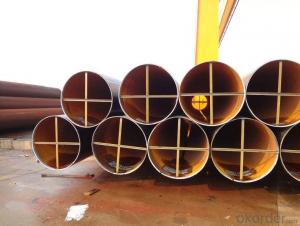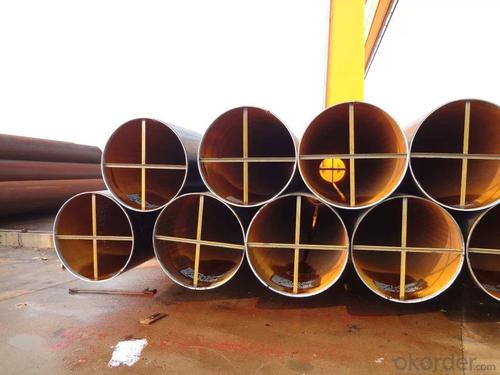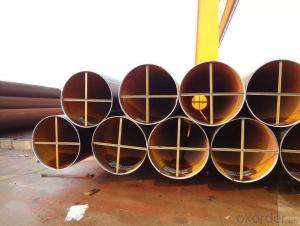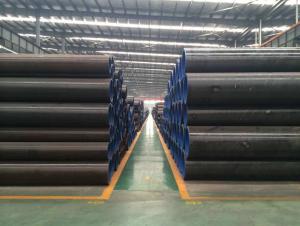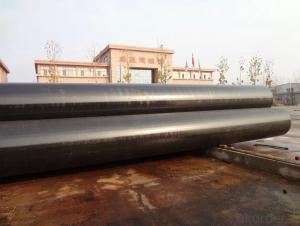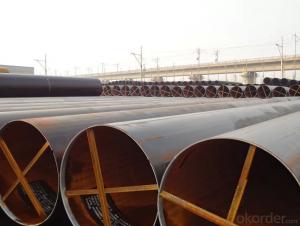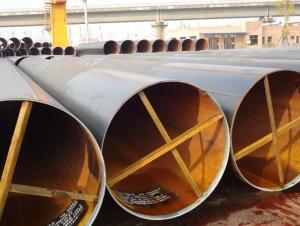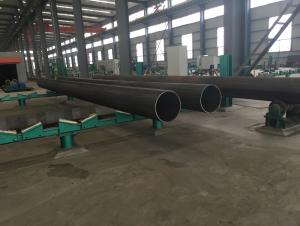Large diameter longitudinal submerged arc welded pipe
- Loading Port:
- Tianjin
- Payment Terms:
- TT or LC
- Min Order Qty:
- 25 m.t.
- Supply Capability:
- 6000 m.t./month
OKorder Service Pledge
OKorder Financial Service
You Might Also Like
Product Description:
1.Specification of Large diameter longitudinal submerged arc welded pipe:
1)Application: It is widely applied to line pipe in oil and sewage transportation , and it is used in Low pressure liquid and gassy transportation and it is also good Structure pipe in building and bridge field.
2)Standard:ASTM A53,ASTM A671 ,ASTM A672 .ASTM A252 API 5L (PSL-1,PSL-2) ,API 5L 2B ,2H,2W.DIN1626,DIN17175,DIN1629.JISG 3452,JISG3457/3456,JISG3461.GB 9711.1/SY5037/GB3092
3)Grade:API 5L GR.B, X40, X42, X52, X56, X60, X65, X70.ST37/37-2,ST33,ST35.8,ST35.4.GB 9711.1/SY5037/GB3092
2.Large diameter longitudinal submerged arc welded pipe Size:
OD: 406.4MM-1422MM (16”-56”)
Thickness: 8MM-50.8MM depends on OD
3. Packing & Delivery
Packing Detail: bundles with anti-rust painting and with plastic cap
Delivery Term: 30 days after receving payment or L/C
4.Large diameter longitudinal submerged arc welded pipe Data Sheet:
Standard: APISPEC 5L
Mechanical Properties
Standard | Grade | (MPa) | (MPa) | ||
Yield strength | Tensile Strength | ||||
API SPEC 5L | PSL1 | ||||
B | ≥241 | ≥414 | |||
×42 | ≥290 | ≥414 | |||
×46 | ≥317 | ≥434 | |||
×52 | ≥359 | ≥455 | |||
×56 | ≥386 | ≥490 | |||
×60 | ≥414 | ≥517 | |||
×65 | ≥448 | ≥531 | |||
×70 | ≥483 | ≥565 | |||
PSL2 | |||||
| Min | Max | Min | Max | |
B | 241 | 448 | 441 | 758 | |
×42 | 290 | 496 | 414 | 758 | |
×46 | 317 | 524 | 434 | 758 | |
×52 | 359 | 531 | 455 | 758 | |
×56 | 386 | 544 | 490 | 758 | |
×60 | 414 | 565 | 517 | 758 | |
×65 | 448 | 600 | 531 | 758 | |
×70 | 483 | 621 | 565 | 758 | |
Chemical Composition(%)
Standard | Grade | C | Mn | P | S | CEV |
Max | Max | Max | Max | Max | ||
PSL1 |
- | |||||
B | 0.26 | 1.2 | 0.030 | 0.030 | ||
×42 | 0.26 | 1.3 | 0.030 | 0.030 | ||
×46,×52,×56,X60 | 0.26 | 1.4 | 0.030 | 0.030 | ||
X65 | 0.26 | 1.45 | 0.030 | 0.030 | ||
X70 | 0.26 | 1.65 | 0.030 | 0.030 | ||
PSL2 |
0.43 | |||||
B | 0.22 | 1.20 | 0.025 | 0.015 | ||
×42 | 0.22 | 1.30 | 0.025 | 0.015 | ||
×46,×52,×56, X60 | 0.22 | 1.40 | 0.025 | 0.015 | ||
X65 | 0.22 | 1.45 | 0.025 | 0.015 | ||
X70 | 0.22 | 1.65 | 0.025 | 0.015 | ||
5. Large diameter longitudinal submerged arc welded pipe Products Showroom:
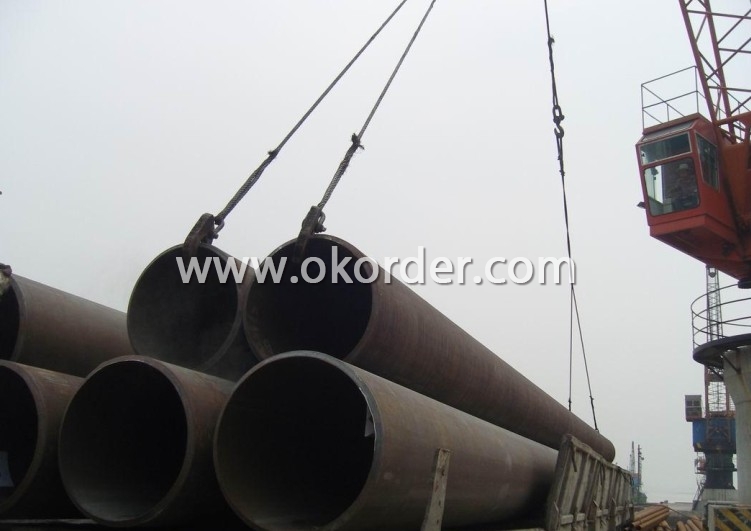
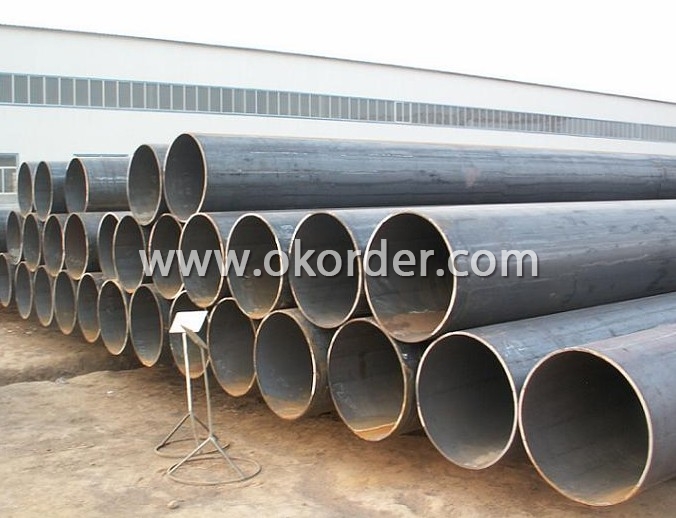
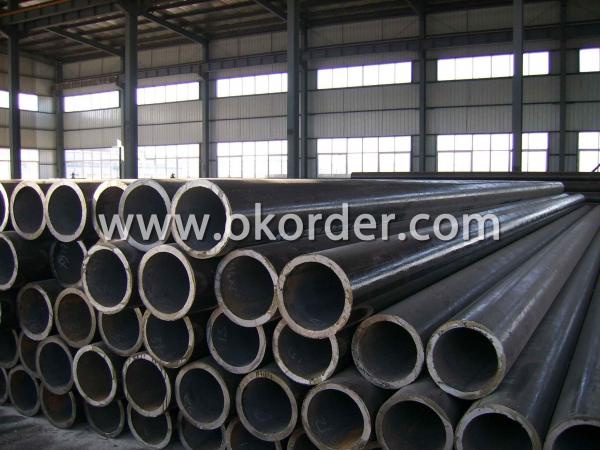
- Q: What are the different types of steel pipe fittings for industrial applications?
- There are several different types of steel pipe fittings commonly used in industrial applications. These include elbows, tees, couplings, unions, reducers, flanges, and caps. Each of these fittings serves a specific purpose in connecting and directing the flow of fluids or gases within a piping system.
- Q: How long do steel pipes typically last?
- Steel pipes typically have a lifespan of 50 to 100 years, depending on various factors such as the quality of the steel, installation conditions, maintenance, and exposure to corrosive elements.
- Q: How are steel pipes connected together?
- Steel pipes are typically connected together using various methods such as welding, threading, or using couplings.
- Q: What's the difference between stainless steel seamless tube and stainless steel welded pipe?
- Stainless steel seamless steel tube is a kind of steel strip with hollow section and without seams.
- Q: What is the importance of corrosion resistance in steel pipes?
- The importance of corrosion resistance in steel pipes is significant as it helps to extend the lifespan of the pipes, ensures their structural integrity, and maintains the quality of the fluid or gas being transported. Corrosion can lead to pipe failures, leaks, and contamination of the contents, resulting in costly repairs, environmental hazards, and potential safety risks. Therefore, incorporating corrosion-resistant properties in steel pipes is crucial for their long-term performance, durability, and overall efficiency.
- Q: What is the maximum allowable pressure for steel pipes?
- Various factors, such as the type of steel used, the pipe's diameter and thickness, and specific industry requirements, determine the maximum pressure allowed for steel pipes. The American Society of Mechanical Engineers (ASME) offers guidelines and standards for pressure vessel and piping design, which include determining the maximum allowable pressure. For power piping and process piping, ASME B31.1 and B31.3 are commonly used codes, respectively. These codes establish design criteria for different materials, including steel, and provide formulas and charts to calculate the maximum allowable pressure for different pipe sizes and wall thicknesses. The maximum allowable pressure is typically determined based on the pipe's ability to withstand internal pressure without experiencing permanent deformation or failure. It is important to consider other factors, such as temperature, corrosion, and the presence of external loads or stresses, as they may also impact the maximum allowable pressure for steel pipes. Therefore, it is essential to refer to the relevant codes, standards, and engineering calculations specific to the application to ensure the safe and reliable operation of steel pipes under the given conditions.
- Q: How do steel pipes handle water hammer in high-rise buildings?
- Steel pipes in high-rise buildings are designed to handle water hammer by incorporating various features. Firstly, these pipes are often equipped with pressure relief valves or surge tanks that absorb and dissipate the sudden pressure changes caused by water hammer. Additionally, engineers use techniques such as proper pipe sizing, installation of air chambers, and use of flexible connectors to minimize the effects of water hammer. These measures help to reduce the sudden pressure spikes and prevent damage to the pipes and other plumbing components in high-rise buildings.
- Q: How are steel pipes used in the manufacturing of food processing equipment?
- Steel pipes are commonly used in the manufacturing of food processing equipment due to their durability, strength, and resistance to corrosion. These pipes are used to transport various food products such as liquids, powders, and gases within the equipment. They are also utilized in the construction of frames, supports, and structures for food processing machinery, ensuring stability and longevity. Additionally, steel pipes are often employed in the creation of heat exchangers, which are crucial for heating or cooling purposes in food processing equipment.
- Q: What is the role of steel pipes in the transportation of chemicals?
- The role of steel pipes in the transportation of chemicals is to provide a strong, durable, and corrosion-resistant conduit for safely moving various types of chemicals from one location to another. Steel pipes are known for their high strength and ability to withstand high pressure, making them suitable for handling hazardous or aggressive substances. Additionally, the smooth interior surface of steel pipes minimizes friction, allowing for efficient and continuous flow of chemicals. The steel material is also resistant to chemical reactions, ensuring the integrity and purity of the transported substances. Overall, steel pipes play a crucial role in ensuring the safe and efficient transportation of chemicals, protecting both the environment and human health.
- Q: What are the different methods of lining steel pipes?
- There are several methods of lining steel pipes, including cement lining, epoxy lining, polyethylene lining, and bituminous lining. These methods are used to protect the inside surface of the steel pipes from corrosion, erosion, and other forms of damage, ensuring their longevity and optimal performance.
Send your message to us
Large diameter longitudinal submerged arc welded pipe
- Loading Port:
- Tianjin
- Payment Terms:
- TT or LC
- Min Order Qty:
- 25 m.t.
- Supply Capability:
- 6000 m.t./month
OKorder Service Pledge
OKorder Financial Service
Similar products
Hot products
Hot Searches
Related keywords
